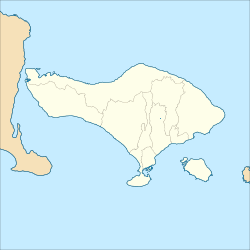Tibubeneng
In this article, we will explore the fascinating world of Tibubeneng. From its impact on today's society to its influence on past history, Tibubeneng has played a crucial role in multiple aspects of human life. Over the decades, Tibubeneng has evolved and adapted to changes in the world, demonstrating its relevance in various areas. With a multidisciplinary approach, we will analyze the different perspectives and facets of Tibubeneng, to better understand its importance and its place on the global stage. Join us on this tour of Tibubeneng and discover everything this theme has to offer.
Tibubeneng | |
|---|---|
Village | |
 Tibubeneng village admin building | |
| Coordinates: 8°38′49″S 115°09′1″E / 8.64694°S 115.15028°E | |
| Country | Indonesia |
| Province | Bali |
| Government | |
| • Perbekel | I Made Kamajaya |
| Area | |
• Total | 6.50 km2 (2.51 sq mi) |
| [2] | |
| Population (2018) | |
• Total | 10,919[1] |
| Website | desatibubeneng.badungkab.go.id |
Tibubeneng is a village in the south of Bali, Indonesia.
Tibubeng was part of Canggu until it was split off in 1997. It is headed by an elected perbekel, or village head.[3] The village has five elementary schools and one junior high school.[4] The majority of the inhabitants follow Balinese Hinduism, although there is a large Muslim minority.[5] In 2018, as part of the Berawa Beach Festival, a total of 5,555 kecak dancers performed simultaneously, setting a world record.[6]
Notes
- ^ Jumlah Penduduk 2021.
- ^ Central Statistics Agency 2017, p. 5.
- ^ Sejarah desa 2021.
- ^ Central Statistics Agency 2017, pp. 35–37.
- ^ Central Statistics Agency 2017, pp. 47–48.
- ^ Antara Bali 2018.
References
- "5.555 penari pecahkan rekor dunia Tari Kecak Kolosal" [5,555 dancers break the world record in a Colossal Kecak Dance] (in Indonesian). Antara Bali. 26 February 2018. Retrieved 12 July 2021.
- "Jumlah Penduduk (Population)". Tibubeneng village, Badung Regency website. 2021. Retrieved 12 July 2021.
- "Kuta Utara dalam Angka 2017" [North Kuta Substrict in Figures 2017] (in Indonesian). Badan Pusat Statistik (Central Statistics Agency). 2017. p. 5. Retrieved 12 July 2021.
- "Sejarah desa (History of the village)". Tibubeneng village, Badung Regency website. 2021. Retrieved 12 July 2021.
